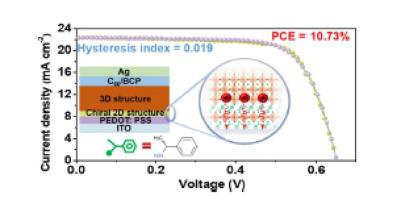Journal of Energy Chemistry ( IF 13.1 ) Pub Date : 2021-09-23 , DOI: 10.1016/j.jechem.2021.09.019 Weiyin Gao 1 , He Dong 1 , Nan Sun 1 , Lingfeng Chao 1 , Wei Hui 1 , Qi Wei 2 , Hai Li 3 , Yingdong Xia 3 , Xingyu Gao 4 , Guichuan Xing 2 , Zhongbin Wu 1 , Lin Song 1 , Peter Müller-Buschbaum 5, 6 , Chenxin Ran 1 , Yonghua Chen 3

|
Pb-free Sn-based perovskite solar cells (PSCs) have recently made inspiring progress, and power conversion efficiency (PCE) of 14.8% has been achieved. However, due to the energy-level mismatch and poor interfacial contact between commonly used hole transport layer (i.e., poly(3,4-ethylenedioxythiophene):poly(styrene sulfonate), PEDOT:PSS) and FASnI3 film, it is still challenging to effectively extract holes at the interface. Owing to the p-type nature of Sn-based perovskites, the efficient hole extraction is of particular significance to improve the PCE of their solar cells. In this work, for the first time, the role of chiral cations, α-methylbenzylamine (S-/R-/rac-MBA), in promoting hole transportation of FASnI3-based PSCs is demonstrated. The introduction of MBAs is found to form 2D/3D film with low-dimensional structures locating at PEDOT:PSS/FASnI3 interface, which facilitates the energy level alignment and efficient charge transfer at the interface. Importantly, chiral-induced spin selectivity (CISS) effect of R-MBA2SnI4 induced by chiral R-MBA cation is found to further assist the specific interfacial transport of accumulated holes. As a result, R-MBA-based PSCs achieve decent PCE of 10.73% with much suppressed hysteresis and enhanced device stability. This work opens up a new strategy to efficiently promote the interfacial extraction of accumulated charges in working PSCs.
中文翻译:

手性阳离子促进高效锡基钙钛矿太阳能电池的界面电荷提取
无铅锡基钙钛矿太阳能电池 (PSC) 最近取得了令人鼓舞的进展,功率转换效率 (PCE) 已达到 14.8%。然而,由于常用的空穴传输层(即聚(3,4-亚乙基二氧噻吩):聚(苯乙烯磺酸盐)、PEDOT:PSS)和FASnI 3薄膜之间的能级失配和界面接触不良,这仍然具有挑战性以有效地提取界面处的孔洞。由于 Sn 基钙钛矿的 p 型性质,有效的空穴提取对于提高其太阳能电池的 PCE 具有特别重要的意义。在这项工作中,第一次,手性阳离子的作用,α-甲基苄胺(S - / R - / rac-MBA),在促进基于FASnI 3的 PSC 的空穴传输方面得到了证明。发现 MBA 的引入形成了位于 PEDOT:PSS/FASnI 3界面的具有低维结构的 2D/3D 薄膜,这有助于界面处的能级对齐和有效的电荷转移。重要的是,发现由手性R- MBA 阳离子诱导的R- MBA 2 SnI 4的手性诱导自旋选择性 (CISS) 效应进一步有助于累积空穴的特定界面传输。结果,R-基于 MBA 的 PSC 实现了 10.73% 的 PCE,同时大大抑制了滞后现象并增强了设备稳定性。这项工作开辟了一种新策略,可有效促进工作 PSC 中累积电荷的界面提取。


























 京公网安备 11010802027423号
京公网安备 11010802027423号